In 2024, the Internet of Things (IoT) continues to play a pivotal role in reshaping industries and daily life. IoT devices' rapid growth and integration have revolutionized how we connect and interact with physical objects, making processes more efficient and data-driven. However, IoT presents opportunities and significant IoT challenges that businesses and individuals must contend with.
Aloa, an expert in software outsourcing, helps businesses and startups navigate these challenges by providing valuable insights and solutions. One of the significant hurdles in the IoT landscape is security challenges. The rise of IoT devices has also brought forth security risks, such as unauthorized access to sensitive information, data breaches, and potential vulnerabilities in IoT systems. Aloa highlights best practices to secure IoT devices, emphasizing the importance of regular testing, software updates, and network security measures.
In this blog, we delve deeper into the IoT challenges that 2024 presents. From data privacy concerns and lack of standardization to interoperability issues and the ever-evolving cyber threats, we will explore the intricacies of these challenges and provide actionable solutions. Afterward, you will understand the significant challenges associated with IoT in 2024 and be equipped with the knowledge to tackle them effectively, ensuring the safe and successful deployment of IoT solutions in your endeavors.
Let's dive in!
10 IoT Challenges to Consider in 2024
As we enter 2024, the Internet of Things (IoT) continues shaping our digital landscape. With the ever-expanding network of interconnected devices, IoT offers immense potential but brings many challenges. Let's explore the top 10 IoT challenges that demand attention in 2024.
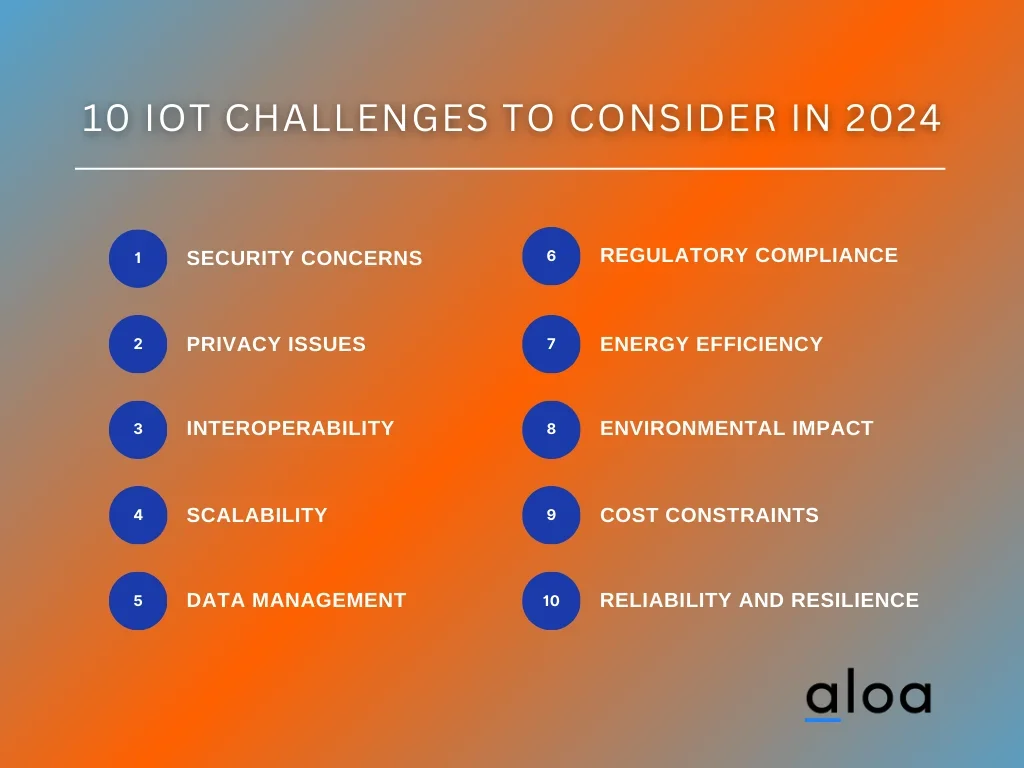
1. Security Concerns
Security concerns remain a top challenge in the IoT landscape. As IoT devices continue to increase, they become increasingly attractive cyberattack targets. Ensuring the security of both devices and data is paramount to prevent breaches. Some specific security issues and challenges in IoT include:
- Cyberattacks: IoT vulnerabilities invite various threats like malware, DDoS attacks, and unauthorized access.
- Data Theft: Hackers target sensitive IoT data, jeopardizing user privacy and finances.
- Unpatched Vulnerabilities: Many IoT devices lack proper patching mechanisms, leaving them exploitable.
- Privacy Concerns: IoT collects vast amounts of personal data, triggering privacy worries and legal compliance issues.
- Insider Threats: Employees with privileged access may trigger insider threat indicators (misuse IoT systems, manipulate devices, or exfiltrate sensitive data).
- Network Security: Securing IoT networks requires encryption, gateway protection, and access control.
- Device Authentication: Weak authentication exposes IoT devices to unauthorized access, necessitating robust protocols.
- API and App Security: Insecure interfaces can be exploited, demanding secure IoT device communication.
- User Passwords: Weak IoT passwords invite easy attacks, highlighting the need for more robust policies.
- Firmware Updates: Timely updates are vital to fix IoT vulnerabilities.
- Physical Security: Protecting IoT devices from physical tampering is crucial.
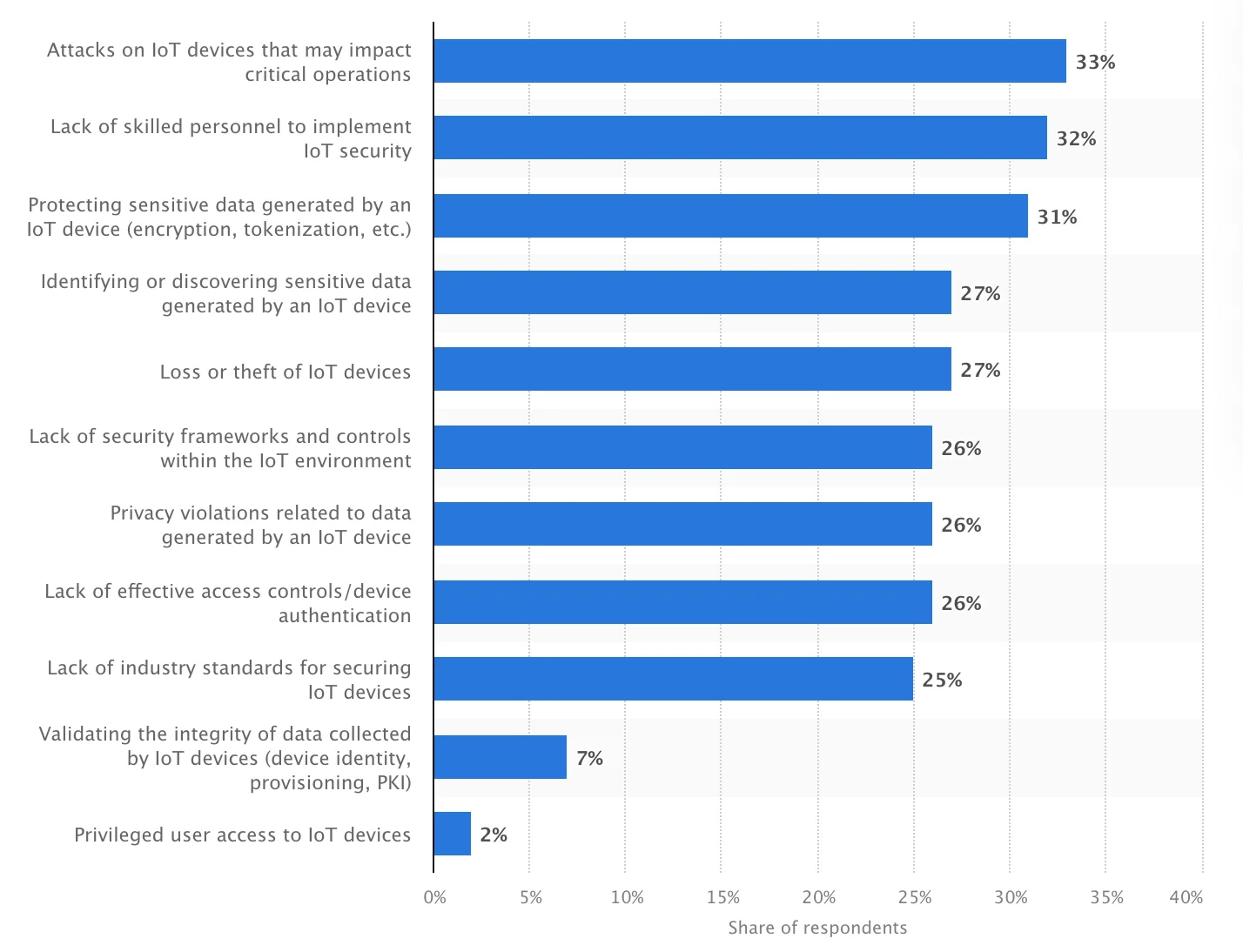
In 2019, 33% of respondents globally expressed concerns about IoT device attacks. Additionally, 99% of respondents cited concerns about IoT data security, including a lack of skilled personnel and safeguarding sensitive data. IoT encompasses internet-connected devices that collect and transmit data without human interaction. With the growing deployment of IoT devices, ensuring security and effective data encryption and identity protection have become increasingly critical.
Addressing these IoT security challenges is the first step in creating a robust and trustworthy IoT ecosystem, safeguarding sensitive data, and providing a secure environment for users and organizations.
2. Privacy Issues
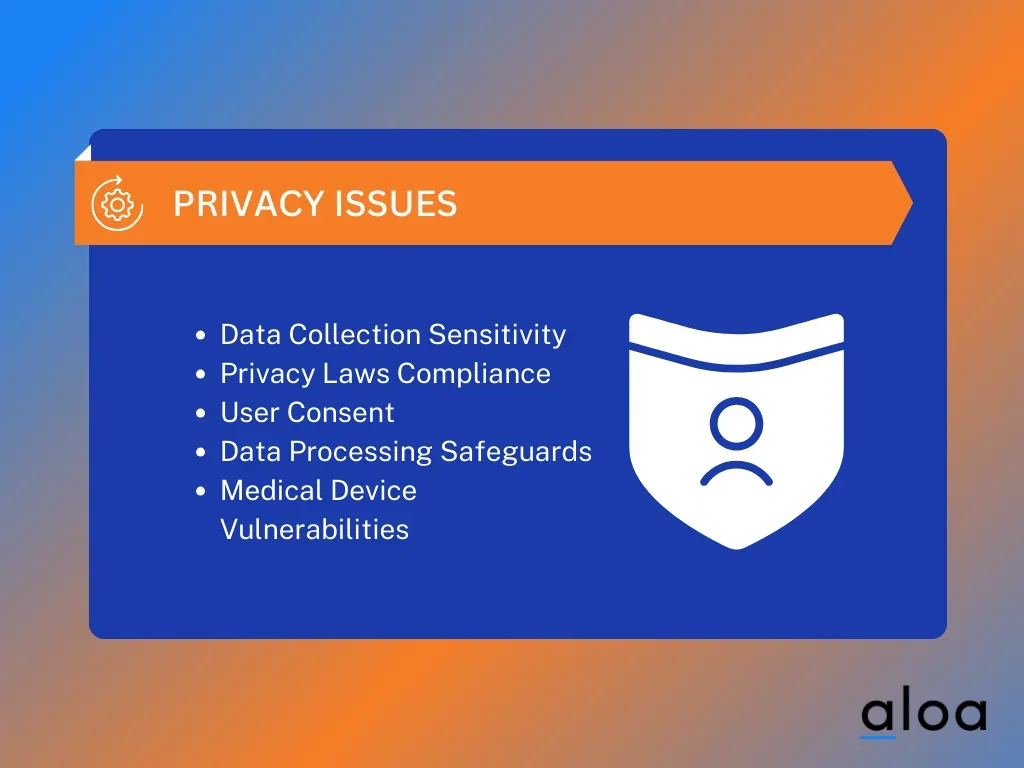
IoT challenges encompass various concerns, with privacy issues taking center stage in this digital landscape. Balancing data collection from IoT devices while respecting user privacy remains a significant challenge. Here are some key points highlighting these challenges:
- Data Collection Sensitivity: IoT devices continuously gather personal information, raising concerns about unauthorized access and misuse by cyber criminals.
- Privacy Laws Compliance: With evolving privacy laws worldwide, IoT developers face difficulties ensuring compliance while collecting large amounts of data.
- User Consent: Obtaining informed consent for data collection is crucial. IoT development teams must create interfaces that clearly explain data usage to users.
- Data Processing Safeguards: IoT solutions often involve real-time data processing. Implementing suitable algorithms, firewalls, and business VPNs is essential to protect user data from attackers.
- Medical Device Vulnerabilities: IoT-enabled medical devices, while beneficial, pose unique privacy challenges, as breaches can have severe consequences.
Privacy issues in IoT challenges extend beyond simple data collection; they encompass usability, connectivity, and data security. Addressing these challenges effectively is essential to prevent financial loss and maintain users' trust in the IoT ecosystem. As IoT continues to evolve, vigilance in safeguarding personal information remains crucial.
3. Interoperability
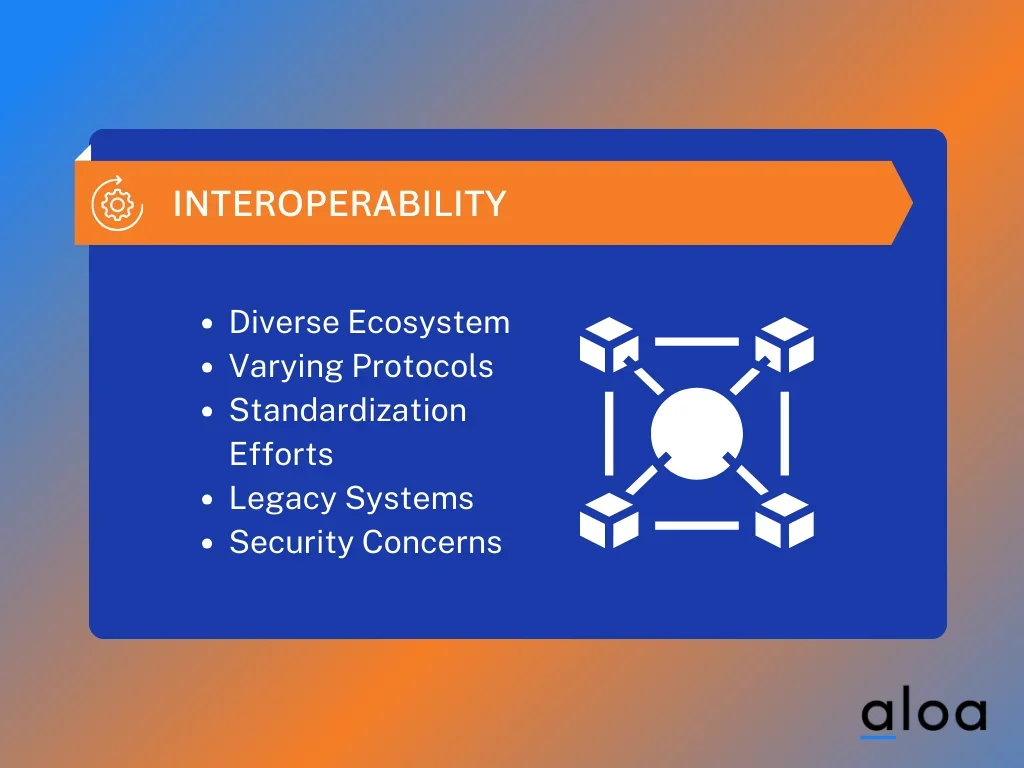
Interoperability is one of the most pressing IoT challenges that the industry faces today. The diversity of IoT devices, originating from various manufacturers and utilizing different communication protocols, poses significant hurdles to creating a cohesive IoT ecosystem. Here are the critical aspects of this challenge:
- Diverse Ecosystem: The IoT landscape comprises sensors, actuators, and smart appliances, each designed for specific purposes. Achieving interoperability means ensuring that this diverse array of devices can communicate effectively.
- Varying Protocols: Different manufacturers often employ proprietary communication protocols. This fragmentation makes it difficult for devices to understand and interact with one another.
- Standardization Efforts: Industry-wide standardization efforts, such as developing communication protocols like MQTT and CoAP, aim to address this challenge. However, widespread adoption is still a work in progress.
- Legacy Systems: Many existing IoT devices operate on older protocols, further complicating interoperability as newer devices must be retrofitted to work with them.
- Security Concerns: Interoperability efforts must also consider security implications. Integrating devices from different sources can introduce vulnerabilities if not handled carefully.
Solving IoT challenges related to interoperability requires continued collaboration among industry stakeholders, the development and adoption of open standards, and innovative solutions that bridge the gaps between devices, ultimately creating a more seamless and interconnected IoT ecosystem.
4. Scalability
Scalability is one of the most pressing IoT challenges. As the number of IoT devices proliferates, managing and scaling IoT infrastructures becomes increasingly complex. Organizations encounter scalability challenges on multiple fronts, encompassing data storage, processing, and management.
IoT generates a colossal volume of data, and handling this influx efficiently requires scalable data storage solutions that can grow seamlessly with the expanding device ecosystem. Moreover, the processing power needed to analyze and derive actionable insights from this data must also scale effectively to maintain real-time responsiveness.
Managing a vast and diverse array of IoT devices also presents scalability hurdles. Ensuring these devices can be seamlessly integrated into existing networks and systems while maintaining security and reliability becomes progressively intricate as the IoT landscape evolves.
5. Data management
Data management is pivotal to the Internet of Things (IoT). IoT systems generate vast volumes of data, posing significant challenges in real-time handling, processing, and analyzing this information. Effective data management solutions are imperative to ensure the seamless operation of IoT ecosystems.
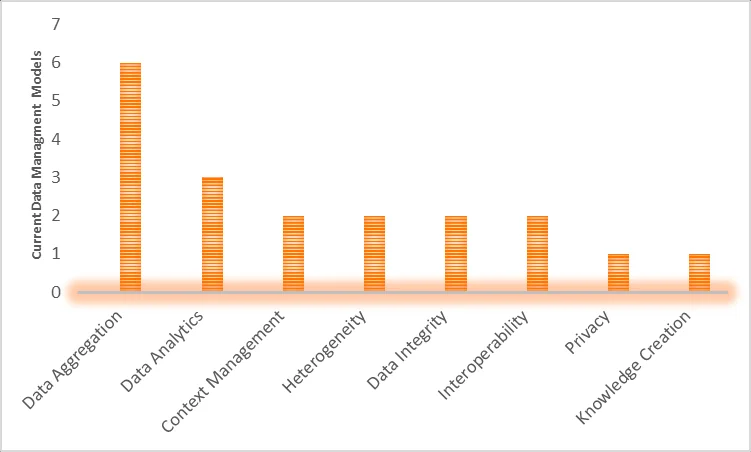
This figure illustrates various challenges related to IoT data management. These challenges are depicted horizontally, while the vertical lines indicate the frequency of data management models documented in the literature. A notable observation from the literature review is the limited research attention given to several data management challenges, including data aggregation, analysis, and storage.
Organizations must implement robust data management strategies encompassing data collection, storage, transmission, and analysis to address this challenge. They must invest in scalable and efficient data storage solutions, leverage advanced data analytics tools, and establish secure data transmission protocols. Real-time processing capabilities are essential to derive actionable insights promptly.
6. Regulatory Compliance
Regulatory compliance is a paramount concern. IoT systems frequently function within environments subject to many compliance prerequisites, notably Europe's General Data Protection Regulation (GDPR). Adhering to these stringent regulations while concurrently expanding IoT operations poses a multifaceted challenge.
Ensuring compliance necessitates a meticulous approach to data handling, user consent, and privacy protection. IoT stakeholders must meticulously navigate the intricate web of legal mandates and adapt their systems to meet evolving regulatory standards. This demands continuous vigilance, proactive measures, and a comprehensive understanding of the legal landscape to mitigate potential legal and financial ramifications.
Incorporating compliance considerations into the very fabric of IoT development and deployment is essential. This entails robust data encryption, user consent mechanisms, and transparent data management practices. The stakes are high; non-compliance can lead to severe penalties and erode user trust. Thus, IoT entities must embrace regulatory compliance as a core principle to ensure responsible and sustainable growth of IoT ecosystems.
7. Energy Efficiency
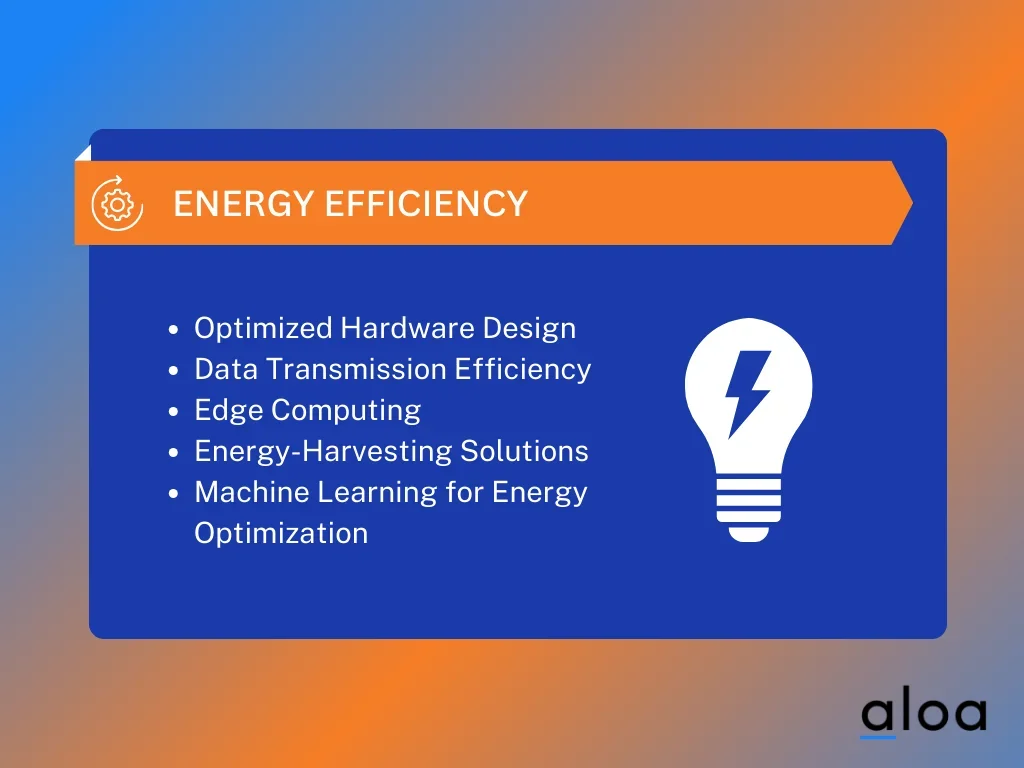
IoT challenges extend to energy efficiency as an integral concern. Many IoT devices rely on battery power, so enhancing energy efficiency for prolonged battery life and reduced environmental impact becomes paramount. This challenge encompasses:
- Optimized Hardware Design: IoT devices with low-power components and efficient power management systems must be engineered for energy efficiency.
- Data Transmission Efficiency: Efficient data transmission protocols, such as MQTT, are vital in reducing energy consumption during data exchange.
- Edge Computing: Processing data at the edge before transmitting it to the cloud can significantly reduce the energy required for data transmission.
- Energy-Harvesting Solutions: Implementing energy-harvesting technologies, like solar panels or kinetic energy generators, can help recharge IoT device batteries sustainably.
- Machine Learning for Energy Optimization: Employing machine learning algorithms to analyze usage patterns and optimize energy consumption in real time.
In tackling the IoT energy efficiency challenges, these strategies ensure IoT devices operate longer on a single charge, reducing the need for frequent battery replacement and contributing to a greener, more sustainable IoT ecosystem.
8. Environmental Impact
IoT challenges encompass a range of concerns related to their environmental impact. The proliferation of IoT devices has raised significant apprehensions about their contribution to environmental issues, particularly e-waste and energy consumption. We must focus on developing sustainable IoT solutions to mitigate these challenges. Here are some key aspects of the environmental impact of IoT:
- E-waste Generation: The rapid turnover of IoT devices leads to increased electronic waste. Proper recycling and disposal mechanisms are needed to address this issue.
- Energy Consumption: Many IoT devices operate 24/7, consuming energy continuously. Implementing energy-efficient designs and technologies is essential to reduce their carbon footprint.
- Resource Usage: IoT device manufacturing requires various resources, including rare minerals. Sustainable sourcing and efficient production processes are vital.
- Carbon Emissions: Energy-intensive data centers that support IoT infrastructure can contribute to carbon emissions. Renewable energy adoption and energy-efficient data centers are crucial.
- Sustainability: Ensuring the long-term sustainability of IoT ecosystems involves minimizing environmental impact at every stage, from production to end-of-life disposal.
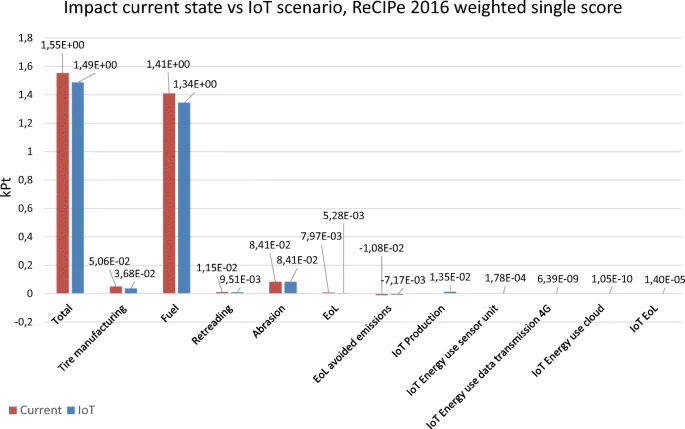
In most impact categories, the IoT scenario generally has a reduced impact. Yet, the IoT scenario exhibits a notably higher impact in four areas—freshwater eutrophication, freshwater ecotoxicity, marine ecotoxicity, and human non-carcinogenic toxicity. This increased impact primarily arises from IoT hardware production.
9. Cost Constraints
IoT challenges in 2024 are poised to shape the Internet of Things landscape. Cost constraints in IoT remain a pressing issue, hindering widespread adoption and implementation. Here are key factors contributing to these constraints:
- Device Manufacturing Costs: Developing IoT devices with advanced features can be expensive, making them less accessible for consumers and businesses.
- Connectivity Expenses: Maintaining IoT connectivity, especially in remote or expansive areas, can be costly due to the need for reliable network infrastructure.
- Data Management: As data volumes surge, storing, processing, and securing IoT-generated data necessitate substantial investments in infrastructure and cybersecurity.
- Upgrade and Maintenance: Ensuring the longevity and reliability of IoT devices requires continuous updates and maintenance, incurring additional costs.
- Compliance and Regulations: Adhering to evolving regulatory requirements, such as data privacy laws, often entails financial investments in compliance measures.
Addressing these IoT challenges requires innovative, cost-effective solutions and strategic planning to unlock the full potential of IoT technology in 2024.
10. Reliability and Resilience
Reliability and resilience in the IoT ecosystem present significant challenges. Ensuring that IoT systems operate consistently and can withstand disruptions is paramount. These challenges stem from various sources, including network connectivity issues, hardware failures, and cybersecurity threats. Reliability concerns demand robust device design and effective fault tolerance mechanisms. IoT devices must continue functioning even when faced with unexpected failures.
Resilience, however, requires the ability to recover quickly from disruptions. This entails real-time monitoring, predictive maintenance, and the capacity to reroute data and operations when failures occur. Cybersecurity is crucial in reliability and resilience, as vulnerabilities can lead to system downtime or data breaches. Organizations must invest in comprehensive security measures to safeguard their IoT infrastructure like using multi-factor authentication and password managers.
In 2024, addressing reliability and resilience challenges will remain critical as IoT applications expand across industries, from healthcare to smart cities, where uninterrupted operation and data integrity are imperative for success.
Potential Solutions to the IoT Challenges
The Internet of Things (IoT) has rapidly evolved to become an integral part of our daily lives, revolutionizing industries, enhancing convenience, and offering unprecedented opportunities for innovation. However, with its widespread adoption, IoT challenges have also emerged, posing significant obstacles to seamless integration into various domains.
Let's explore seven potential solutions to these IoT challenges, emphasizing the need for proactive measures to ensure a secure, reliable, and scalable IoT ecosystem.
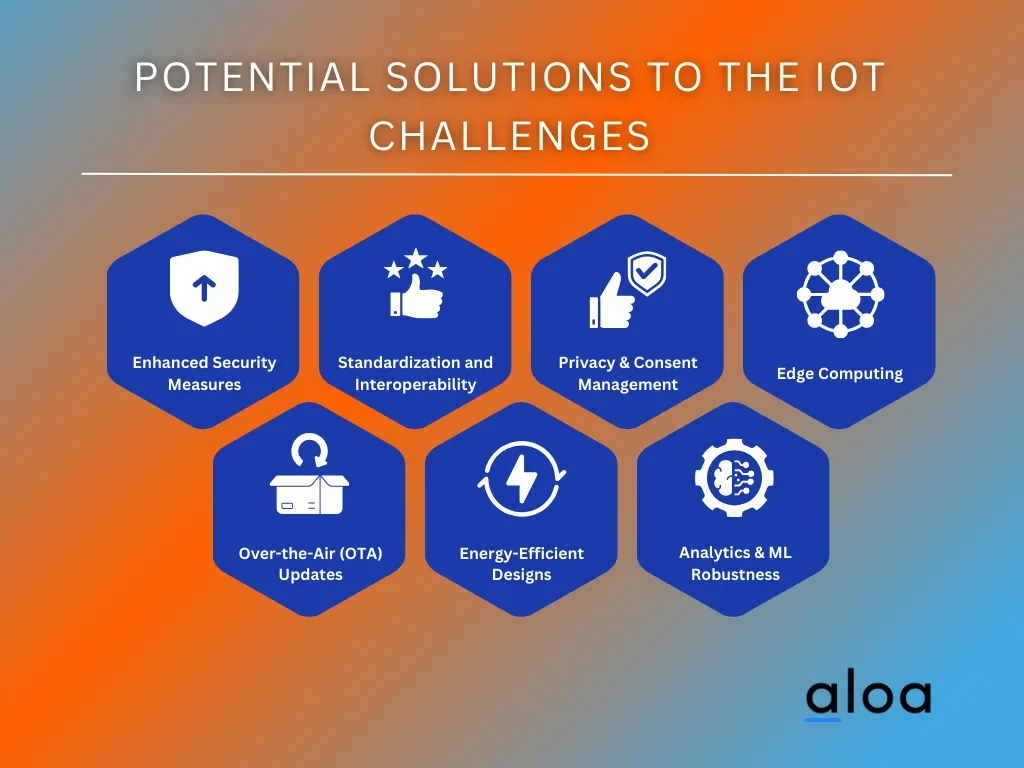
Enhanced Security Measures
One of the most critical challenges in the IoT landscape is security. The interconnected nature of IoT devices exposes them to various vulnerabilities, making them attractive targets for cyberattacks. To mitigate these risks, organizations must prioritize security. Implementing robust encryption protocols, authentication mechanisms, and regular security audits can help safeguard IoT networks and devices. Additionally, educating users about the importance of security practices can reduce the risk of IoT-related breaches.
Standardization and Interoperability
The a need for standardized protocols and interoperability to ensure the seamless integration of IoT devices from different manufacturers. To address this challenge, industry stakeholders must collaborate on developing and adopting common standards and protocols. Standardization enables devices from different vendors to communicate effectively, enhancing scalability and reducing compatibility issues, ultimately leading to a more cohesive IoT ecosystem.
Data Privacy and Consent Management
As IoT devices collect and transmit vast amounts of data, concerns about data privacy and consent have grown. Organizations must prioritize data protection by implementing robust data encryption, anonymization techniques, and precise privacy policies. Additionally, providing users with transparent and easily understandable consent mechanisms empowers them to make informed data-sharing choices, fostering trust in IoT applications.
Edge Computing
IoT generates massive data volumes, which can strain network bandwidth and centralized cloud resources. Edge computing offers a solution by processing data closer to the source, reducing latency and alleviating network congestion. Deploying edge computing infrastructure allows IoT devices to perform data processing tasks locally, enhancing real-time decision-making capabilities and reducing the burden on centralized servers.
Over-the-Air (OTA) Updates
IoT devices often require frequent updates to address security vulnerabilities, improve functionality, and ensure compatibility with evolving standards. OTA updates enable manufacturers to deliver these updates remotely, reducing maintenance costs and enhancing the longevity of IoT devices. Implementing secure and efficient OTA update mechanisms is crucial to keep IoT ecosystems up-to-date and secure.
Energy-Efficient Designs
Many IoT devices operate on battery power, and energy efficiency is a significant challenge. IoT manufacturers should prioritize energy-efficient designs to prolong battery life and reduce environmental impact. This includes optimizing hardware components, implementing low-power communication protocols, and leveraging power management techniques to ensure IoT devices can operate for extended periods without frequent recharging or battery replacement.
Robust Analytics and Machine Learning
When harnessed effectively, IoT generates vast amounts of data that can provide valuable insights for businesses and organizations. Deploying robust analytics and machine learning algorithms can help extract actionable information from IoT data streams. These insights can drive informed decision-making, predictive maintenance, and enhanced operational efficiency. By investing in advanced analytics capabilities, organizations can unlock the full potential of their IoT deployments.
Key Takeaway
Identifying IoT challenges and implementing solutions is crucial to the Internet of Things (IoT) landscape. It encompasses security concerns, interoperability issues, scalability, energy efficiency, data management, regulatory compliance, reliability, cost constraints, and environmental impact. As businesses and startups increasingly integrate IoT into their operations, addressing these challenges becomes crucial for success.
By recognizing and proactively tackling IoT problems, businesses can ensure their devices and data's security and privacy, enhance interoperability between devices, optimize energy consumption, efficiently manage vast amounts of data, adhere to regulatory requirements, and build reliable and cost-effective IoT solutions. Moreover, prioritizing sustainability can mitigate the environmental footprint of IoT deployments.
For guidance on navigating these IoT challenges and developing robust IoT solutions, contact us at [email protected]. Our expertise can empower your organization to harness the full potential of IoT while overcoming its inherent obstacles, fostering growth, and ensuring a competitive edge in the market.

